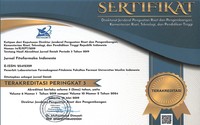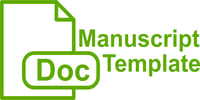Uji Aktivitas Antiinflamasi Teh Cang Salak Secara In Vitro Dengan Metode Stabilisasi Membran Human Red Blood Cell
Abstract
Keywords
Full Text:
PDF (Bahasa Indonesia)References
Arifah, R. N., Idiawati, N. and Wibowo, M. A. (2017) ‘Uji Aktivitas Antiinflamasi Ekstrak Kasar Buah Asam Paya ( Eleiodoxa conferta ( Griff .) Buret) Secara in-vitro dengan Metode Stabilisasi Membran HRBC (human Red Blood Cell)’, Jkk, 6(1), pp. 21–24.
Armadany, F. I. et al. (2020) ‘Uji Potensi Antiinflamasi Ekstrak Etanol Daun Bambu-Bambu (Polygonum pulchrum Blume) Dengan Metode Stabilisasi Membran Sel Darah Merah Secara In Vitro’, Majalah Farmasetika., 4(Suppl 1), pp. 144–151. doi: 10.24198/mfarmasetika.v4i0.25873.
Askandari (2015) Uji Aktivitas Anti Inflamasi Ekstrak Etanol 70% Buah Parijoto (Medinilla speciosa Blume) Secara In Vitro Dengan Metode Stabilisasi Membran HRBC (Human Red Blood Cell), Skripsi. UIN SYARIF HIDAYATULLAH JAKARTA.
Choy, K. W. et al. (2019) ‘Flavonoids as natural anti-inflammatory agents targeting nuclear factor-kappa B (NFκB) signaling in cardiovascular diseases: A mini review’, Frontiers in Pharmacology, 10(OCT), pp. 1–8. doi: 10.3389/fphar.2019.01295.
Dewi, A. A. T. S., Puspawati, N. and Suarya, P. (2015) ‘Aktivitas Antiinflamasi Ekstrak Eter Kulit Batang Tenggulun (Protium Javanicum Burm) Terhadap Edema Pada Tikus Wistar Yang Diinduksi Dengan Karagenan’, Jurnal Kimia, 9(1), pp. 13–19.
Ginwala, R. et al. (2019) ‘Potential role of flavonoids in treating chronic inflammatory diseases with a special focus on teh anti-inflammatory activity of apigenin’, Antioxidants, 8(2), pp. 1–30. doi: 10.3390/antiox8020035.
GÜNEŞ BAYIR, A., AKSOY, A. N. and KOÇYİĞİT, A. (2019) ‘Teh Importance of Polyphenols as Functional Food in Health’, Bezmialem Science, pp. 157–163. doi: 10.14235/bas.galenos.2018.2486.
Hardy, R. S., Slamet, S. and Kamilla, L. (2019) ‘Uji Aktivitas Anti Inflamasi Ekstrak Bawang Dayak (Eleutehrine Americana L. Merr) terhadap Stabilisasi Membran Sel Darah Merah’, Jurnal Laboratorium Khatulistiwa, 2(1), p. 30. doi: 10.30602/jlk.v2i1.324.
Harvard Medical School (2020) Understanding acute and chronic inflammation, Harvard Health Publishing. Available at: https://www.health.harvard.edu/staying-healthy/understanding-acute-and-chronic-inflammation.
Hussain, G. et al. (2018) ‘Role of plant derived alkaloids and tehir mechanism in neurodegenerative disorders’, International Journal of Biological Sciences, 14(3), pp. 341–357. doi: 10.7150/ijbs.23247.
Institute for Quality and Efficiency in Health Care (2018) What is an inflammation? Available at: https://www.ncbi.nlm.nih.gov/books/NBK279298/?report=printable.
Karta, I. W. et al. (2018) Teh Cang Salak :Teh Dari Limbah Kulit Salak Dan Kayu Secang Yang Berpotensi Untuk Pencegahan Dan Pengobatan Penyakit Degeneratif.
Karta, I. W., Iswari, P. A. K. and Susila, L. A. N. K. E. (2019) ‘Teh Cang Salak : Teh Dari Limbah Kulit Salak Dan Kayu Secang Yang Berpotensi Untuk Pencegahan Dan Pengobatan Penyakit Degeneratif’, Meditory : Teh Journal of Medical Laboratory, 7(1), pp. 27–36. doi: 10.33992/m.v7i1.473.
Kumar, N. S. (2011). Evaluation of RBC Membran Stabilization and Antioxidant of Bombax ceiba in An In Vitro Methode. International Journal of Pharma and Bio Sciences, 2(1).
Kumar, V., Bhat, Z. A., Kumar, D., Khan, N. A., and Chashoo, I. A. (2012). Evaluation of Anti-Inflammatory Potential of Leaf Extracts of Skimmia Anquetilia. Asian Pasific Journal of Tropical Biomedicine, 2(8), 627–630.
Murningsih, T. and Fathoni, A. (2019) ‘Evaluasi Aktivitas Anti-Inflamasi dan Antioksidan Secara In-Vitro, Kandungan Fenolat Dan Flavonoid Total Pada Terminalia spp.’, Journal of Chemical Information and Modeling, 53(9), pp. 1689–1699. doi: 10.1017/CBO9781107415324.004.
Peng, J. et al. (2019) ‘Plant-derived alkaloids: Teh promising disease-modifying agents for inflammatory bowel disease’, Frontiers in Pharmacology, 10(APR), pp. 1–15. doi: 10.3389/fphar.2019.00351.
Rahmawati, D., Sugihartini, N. and Yuwono, T. (2017) ‘Daya Antiinflamasi Salep Basis Larut Air Minyak Atsiri Bunga Cengkeh ( Syzygium aromaticum ) dengan Variasi Komposisi Enhancer Asam Oleat dan Propilen glikol’, Berkala Ilmu Kesehatan Kulit dan kelamin, 29(3), pp. 182–187.
Ramadhani, N. and Sumiwi, S. A. (2015) ‘Aktivitas Antiinflamasi Berbagai Tanaman Diduga Berasal Dari Flavonoid’, Farmaka, 14(2), pp. 111–123.
Ratehe, P. et al. (2009) ‘Mechanism of action of flavonoids as anti-inflammatory agents: A review’, Inflammation and Allergy - Drug Targets, 8(3), pp. 229–235. doi: 10.2174/187152809788681029.
Ratehe, P. et al. (2012) ‘Mechanism of Action of Flavonoids as Anti-inflammatory Agents: A Review’, Inflammation & Allergy - Drug Targets, 8(3).
Setianto, R. (2020) Studi Etnomedisine Di Suku Tengger Probolinggo – Jawa Timur Dengan Uji Stabilitas Membran Dan Aktivitas Antiinflamasi Program Studi S2 Ilmu Farmasi Fakultas Farmasi. Universitas Setia Budi.
Singh, A. et al. (2020) ‘Interaction of polyphenols as antioxidant and anti-inflammatory compounds in brain–liver–gut axis’, Antioxidants, 9(8), pp. 1–20. doi: 10.3390/antiox9080669.
Soleha, M. et al. (2018) ‘Profil Penggunaan Obat Antiinflamasi Nonstreoid di Indonesia’, Jurnal Kefarmasian Indonesia, 8(2), pp. 109–117. doi: 10.22435/jki.v8i2.316.
Subowo (2010) Imunologi Klinik. Edisi ke-2. Jakarta: Sagung Seto.
Suryani, Benny, F. and Wahyuni (2018) ‘Uji Efek Antiinflamasi secara In Vivo Nanopartikel Kurkumin yang Diformulasikan menggunakan Metode Reinforcement Gelasi Ionik’, Issn, 1(1), pp. 20–24.
Ti, H. et al. (2021) ‘Progress of plant medicine derived extracts and alkaloids on modulating viral infections and inflammation’, Drug Design, Development and Tehrapy, 15, pp. 1385–1408. doi: 10.2147/DDDT.S299120.
Yahfoufi, N. et al. (2018) ‘Teh immunomodulatory and anti-inflammatory role of polyphenols’, Nutrients, 10(11), pp. 1–23. doi: 10.3390/nu10111618.
DOI: https://doi.org/10.33096/jffi.v10i2.903
Copyright (c) 2023 Jurnal Fitofarmaka Indonesia

This work is licensed under a Creative Commons Attribution-ShareAlike 4.0 International License.
Indexed by:
ISSN: 2356-0398 | e-ISSN: 2541-2329
Editor's Address:
Third Floor Pharmacognosy-phytochemistry laboratory building, Urip Sumoharjo road km. 5 Campus II UMI, Makassar, South Sulawesi, Indonesia
Phone: +6281524045514
Fax: +62411425619
E-mail: editorjfi@umi.ac.id

















.jpg)

